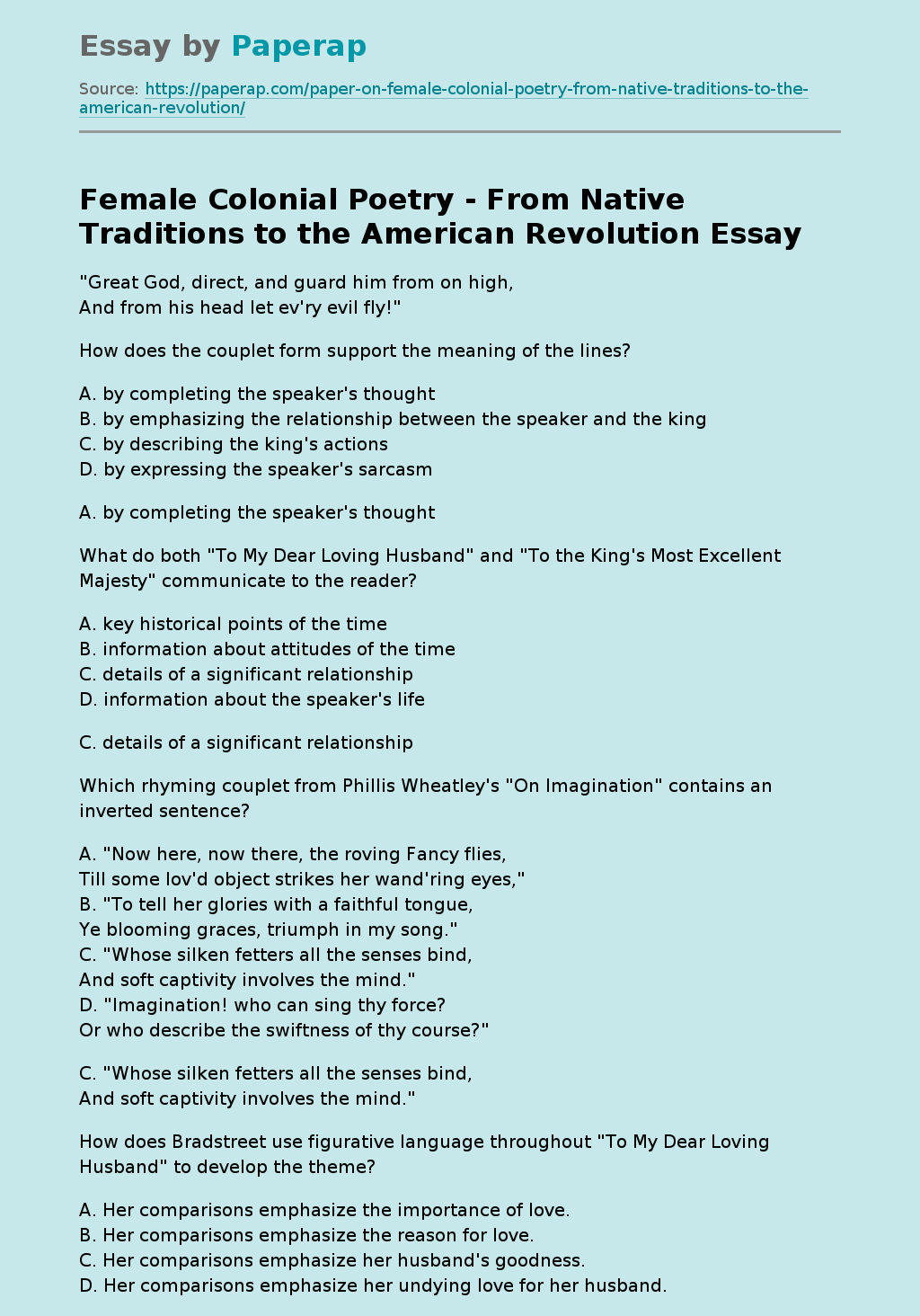Female Colonial Poetry - From Native Traditions to the American Revolution
And from his head let ev’ry evil fly!”
How does the couplet form support the meaning of the lines?
A. by completing the speaker’s thought
B. by emphasizing the relationship between the speaker and the king
C. by describing the king’s actions
D. by expressing the speaker’s sarcasm
A. key historical points of the time
B. information about attitudes of the time
C. details of a significant relationship
D. information about the speaker’s life
A. “Now here, now there, the roving Fancy flies,
Till some lov’d object strikes her wand’ring eyes,”
B. “To tell her glories with a faithful tongue,
Ye blooming graces, triumph in my song.
”
C. “Whose silken fetters all the senses bind,
And soft captivity involves the mind.”
D. “Imagination! who can sing thy force?
Or who describe the swiftness of thy course?”
And soft captivity involves the mind.”
A. Her comparisons emphasize the importance of love.
B. Her comparisons emphasize the reason for love.
C. Her comparisons emphasize her husband’s goodness.
D. Her comparisons emphasize her undying love for her husband.
A. gratitude and loyalty
B. envy and resentment
C. responsibility and obligation
D. growth and maturity
A. love and forgiveness
B. honor and nobility
C. respect and adoration
D. patriotism and nationality
A. Bradstreet’s poem has a thoughtful tone, while Wheatley’s poem has a more nervous tone.
B. Bradstreet’s poem has a soft and loving tone, while Wheatley’s poem has an energetic and excited tone.
C. Bradstreet’s poem has a straightforward and direct tone, while Wheatley’s poem has an evasive and indirect tone.
D. Bradstreet’s poem has an aggressive tone, while Wheatley’s poem has a more relaxed tone.
A. The speaker portrays events in Colonial times.
B. The individual described has high expectations.
C. The poet presents aspects of daily life for female Colonial poets.
D. The speaker celebrates an important figure in her life.
A. Both poets primarily use couplets to link ideas about love and devotion; Bradstreet uses inversion to complete rhymes.
B. Both poets use couplets for rhyme scheme and structure, inverting sentences when needed to maintain the rhyme.
C. Bradstreet uses couplets throughout; Wheatley uses couplets and inverts sentences as needed for emphasis.
D. Bradstreet uses couplets for their overall rhyme scheme and structure; Wheatley uses couplets to enhance the poem as a song of praise.
Live with heav’ns choicest constant blessings crown’d!”
Wheatley uses the word crown’d to express the idea that the king
A. deserves reward for his goodness.
B. requires loyalty from other nations.
C. requires protection from danger.
D. deserves consideration from other nations.
Female Colonial Poetry - From Native Traditions to the American Revolution. (2017, Dec 27). Retrieved from https://paperap.com/paper-on-female-colonial-poetry-from-native-traditions-to-the-american-revolution/

